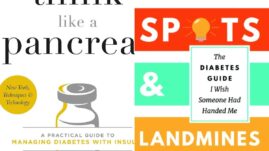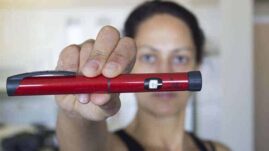What’s your strategy for managing your diabetes during the holidays?
If your plan is to eat yourself into a food coma, you are not alone. Most gatherings this time of year revolve around food and drinks, and usually not the healthy stuff. And I absolutely think there should be room for that!
There should be room for indulgence, throwing your diet to the wind for a few hours and just enjoying being with family and friends.
And yes, of course we can do that even though we live with diabetes. If you are insulin-dependent like me, you just need a solid game plan and you’ll be able to get through the festivities without wreaking havoc on your diabetes management.

My plan for successfully managing my diabetes during the holidays
My plan is fairly straightforward, so it should work for you too:
Know your carb ratios (how much insulin to take to a gram of carbs) – if you don’t know them yet, get a piece of paper and take notes for a few days to get it right. Knowing your daily carb ratios will help you gain good blood sugar control year-round, not just for the holidays. You can read my post about carb ratios and sensitivities to learn more.
Know what you are eating – if you didn’t make it yourself, ask the host. You can’t always see what’s in a dish. Mashed potatoes are usually not just potatoes but also include a lot of butter, milk (or cream), and maybe even sugar.
Bring a carb-counting cheat sheet – It might not be exact, but it’s better than nothing. If you go to your mom’s house during the holidays, you probably know a lot of the food she will be cooking because you have had it since childhood.
Do a little research up front and find out how many carbs are in a serving of your favorite Christmas foods. Maybe you can even get mom’s recipe and calculate the exact carbs? You can find different cheat sheets online or simply make your own.
Work out in the morning – hit the weights before you go out. It will improve your insulin sensitivity and make it easier to manage your blood sugars during the afternoon/night. Not only will you feel better, but your muscles will love the additional carbs and proteins you’ll enjoy later in the day. Why not use all those holiday calories to build some muscles?
Consider increasing your basal rate – if you are sitting down and eating for hours, your basal insulin may need to be turned up. Always consult your healthcare professional before making changes to your insulin dosage, but it might be an idea to increase your basal rate during dinner and throughout the night.
Go for a walk after dinner (or a snowball fight) – it will not only help digestion but also your blood sugar. I’m not even sure this one needs more explanation. Just be sure your sugars don’t crash!
Test, test, test and keep track of active insulin so you don’t overdose – I bring my meter to the table and rely heavily on my CGM. My sugars will have some spikes, and that’s ok, as long as they come down as planned.
Remember to bolus for alcohol – Bolusing for alcohol can be tricky because alcohol can make your sugars drop. My rule of thumb is that I bolus for everything except hard liquor (which I never drink anyway). Especially if your alcohol is mixed with juice or other carb-heavy drinks, you’ll need insulin with that.
And please drink responsibly. It’s really hard to manage anything, and especially your diabetes, if you are out of your mind drunk. If you for some reason aren’t eating but only drinking, be very careful with dosing for alcohol since you’ll have a high likelihood of going low during the night.
Alcohol is tricky, so if you’re drinking and unsure how your blood sugars will react, I suggest having a bedtime snack just to be safe.
To learn more about drinking when you live with diabetes, please read our comprehensive guide: Diabetes & Alcohol: How Does Alcohol Affect Blood Sugar?
What Success Looks Like
I’ve successfully managed my diabetes during the holidays if I’ve enjoyed myself without having to worry about my diabetes too much, if I’ve been able to manage my sugars so that I don’t wake up the next morning in the 200 mg/dL (11 mmol/L) range, and if I haven’t had too many low sugars.
I doubt Santa is going to bring me a new pancreas for Christmas, so it’s a good thing I have learned to manage my diabetes on my own.
Happy Holidays!!!!




Nancy
I have to say being apart of this community is sure helping me be more honest with my eating and snacking habits. Because of all the positive words from other diabetics helps me keep my sugars under better control. I sneak food amost never now and I feel better for it. Thank you!
Christel Oerum
Thank you Nancy – I’m so happy this is a good resource for you
Manju kaushik
It is not only diet management which manages diabetes ,happiness and relaxed mood also play an important role in managing it.
Christel Oerum
I would agree with that. Being stressed out can for sure cause havoc on any diabetes management
Gayle
Funny what you can forget, thanks for reminding me. Thanks for information
Christel Oerum
Glad you found it helpful
HB Pete
Increasing the basal for a long evening is a great new idea
Christel Oerum
Thanks – that’s a bit more tricky but something I often use, even after regular high carb days. You have to slowly test it out though so you don’t crash over night